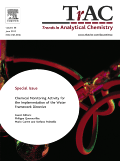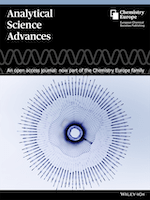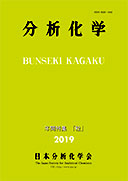
Journal of Analysis and Testing
Scope & Guideline
Advancing analytical excellence for a sustainable future.
Introduction
Aims and Scopes
- Analytical Chemistry Techniques:
The journal emphasizes the development and application of various analytical chemistry techniques, including mass spectrometry, chromatography, and electrochemical sensors, to detect and quantify chemical substances in diverse samples. - Nanotechnology in Sensing:
A core focus is on the use of nanomaterials and nanotechnology to enhance the sensitivity and specificity of sensors, including the development of nanoparticles, quantum dots, and metal-organic frameworks for various applications. - Biomolecular Sensing:
Research on biosensors and biomolecular detection methods is prominent, with studies exploring the use of aptamers, antibodies, and other biological components to create sensitive detection systems for clinical and environmental monitoring. - Environmental and Food Safety Applications:
The journal frequently publishes studies addressing environmental monitoring and food safety, highlighting techniques for the detection of pollutants, toxins, and pathogens in food and water samples. - Emerging Technologies and Methods:
It also covers emerging technologies, such as CRISPR-based detection methods and novel fluorescence techniques, indicating a commitment to exploring cutting-edge advancements in analytical methodologies.
Trending and Emerging
- Fluorescent and Colorimetric Sensing:
There is a growing trend in the development of fluorescent and colorimetric sensors, driven by their simplicity, rapid response time, and applicability in real-time monitoring in various fields, including environmental and clinical diagnostics. - CRISPR and Nucleic Acid-Based Detection Methods:
Research focusing on CRISPR technologies and nucleic acid-based detection methods is on the rise, indicating an increasing interest in leveraging genetic tools for precise and sensitive detection of pathogens and biomarkers. - Integration of Machine Learning with Analytical Techniques:
Emerging studies are beginning to explore the integration of machine learning and artificial intelligence with analytical methods, aiming to enhance data analysis, improve detection accuracy, and facilitate real-time monitoring. - Sustainable and Green Analytical Methods:
There is a notable increase in research emphasizing sustainable and green analytical methods, reflecting a shift towards environmentally friendly practices in the development of analytical techniques and materials. - Microfluidics and Point-of-Care Testing:
The trend towards microfluidic devices and point-of-care testing is expanding, driven by the demand for rapid, on-site diagnostics and the ability to perform complex analyses with minimal sample volumes.
Declining or Waning
- Traditional Immunoassays:
There has been a noticeable decline in publications related to traditional immunoassay techniques, as researchers are increasingly favoring more advanced methods such as mass spectrometry and electrochemical sensors for biomarker detection. - Basic Spectroscopic Techniques:
The frequency of studies solely focused on basic spectroscopic techniques, such as UV-Vis and FTIR spectroscopy, is decreasing, likely due to the rise of more sophisticated and sensitive methods that offer improved analytical capabilities. - Conventional Chemical Analysis:
Research articles centered on conventional chemical analysis methods without the integration of novel materials or technologies are becoming less common, reflecting a shift towards more innovative and hybrid approaches in analytical chemistry.
Similar Journals

JOURNAL OF ANALYTICAL CHEMISTRY
Unveiling Breakthroughs in Instrumentation and ApplicationsJOURNAL OF ANALYTICAL CHEMISTRY, published by PLEIADES PUBLISHING INC, stands as a pivotal resource in the field of analytical chemistry, offering an innovative platform for researchers, professionals, and students to advance their knowledge and contribute to the discourse within the discipline. With an ISSN of 1061-9348 and an E-ISSN of 1608-3199, this journal features a focused exploration of analytical methodologies, instrumentation developments, and applications across various domains, contributing to practical and theoretical advancements in the field. Currently ranked in the Q3 category in Analytical Chemistry with a Scopus rank of #111 out of 156, it provides critical insights and innovation strategies for professionals aiming to enhance their analytical capabilities. Access to the journal is through standard subscription models, and it covers an extensive range of topics pertinent to the discipline from 1996 to 2024. Engage with the JOURNAL OF ANALYTICAL CHEMISTRY to be part of a vibrant research community dedicated to push the boundaries of analytical practices.

Brazilian Journal of Analytical Chemistry
Empowering Researchers Through Open Access KnowledgeBrazilian Journal of Analytical Chemistry, published by VISAO FOKKA COMMUNICATION AGENCY, serves as a vital platform for those engaged in the field of analytical chemistry, especially within the Latin American context. With an ISSN of 2179-3425 and an E-ISSN of 2179-3433, this journal aims to promote high-quality research and advancements in analytical methodologies, instrumentation, and applications spanning from 2010 to the present. Although it currently holds a Q4 rank in Analytical Chemistry by Scopus and is placed at the 24th percentile, its commitment to open access publishing provides invaluable opportunities for widespread dissemination of knowledge, catering to researchers, professionals, and students alike. The journal's editorial board comprises emerging and established experts aiming to bridge gaps in analytical chemistry research, particularly in a Brazilian and broader South American context. Situated in São Paulo, Brazil, the journal's role in fostering innovation and collaboration in analytical techniques makes it an essential resource for the academic community.

TRAC-TRENDS IN ANALYTICAL CHEMISTRY
Connecting Researchers for a Brighter Analytical FutureTRAC - Trends in Analytical Chemistry is a prestigious journal published by Elsevier Science Ltd, situated in the Netherlands. With an impressive impact factor reflected in its Q1 rankings across three major categories—Analytical Chemistry, Environmental Chemistry, and Spectroscopy—this journal stands at the forefront of disseminating pioneering research and advancements in the field of analytical chemistry. Established in 1981, TRAC provides a comprehensive platform for researchers to share influential studies and insights related to the latest trends, methodologies, and technologies in analytical techniques. Recognized globally, the journal excels in fostering cross-disciplinary dialogue and innovation, making it an indispensable resource for academics, professionals, and students alike. Explore the latest issues to stay abreast of cutting-edge developments that shape the analytical sciences.

Analytical and Bioanalytical Chemistry Research
Unlocking the Secrets of Analytical Excellence.Analytical and Bioanalytical Chemistry Research is an esteemed open-access journal published by the Iranian Chemical Society, dedicated to the advancement of knowledge in the fields of analytical chemistry, biochemistry, and spectroscopy. Since its inception in 2014, this journal has provided a platform for researchers, professionals, and students to publish and access high-quality research articles that contribute to the understanding of chemical analysis and bioanalytical methods. With an ISSN of 2383-093X and an open-access model that promotes global dissemination of findings, it ensures that innovative research reaches a broad audience. The journal has consolidated its presence in the scientific community, currently ranked in quartile Q4 for analytical chemistry, biochemistry, and spectroscopy as of 2023. Its Scopus rankings, including a percentile of 34th in Analytical Chemistry, reflect its commitment to quality research and scholarly contribution. Situated in Tehran, Iran, the journal serves as a vital resource for academic discourse, offering insights into emerging trends and methodologies in analytical and bioanalytical chemistry.

Journal of Electroanalytical Chemistry
Driving Discoveries in Analytical Chemistry and BeyondThe Journal of Electroanalytical Chemistry, published by Elsevier Science SA, stands as a leading platform for the dissemination of cutting-edge research in the field of electroanalytical science. With an impressive impact factor that reflects its esteemed reputation—ranking in the Q1 category for both Analytical Chemistry and Chemical Engineering, alongside a strong presence in Electrochemistry—this journal provides a vital resource for researchers, professionals, and students alike. Covering topics from fundamental electrochemical processes to innovative analytical techniques, the journal aims to foster an in-depth understanding and discussion of contemporary advancements in electroanalytical methodologies. Operating under a model that prioritizes quality and rigor, it facilitates access to high-quality manuscripts and reviews that contribute to the advancement of the field. For over six decades, from 1959 to 2024, it has played an intrinsic role in shaping the landscape of electrochemistry, continually driving forward the frontiers of knowledge and application.

Separation Science Plus
Unveiling cutting-edge techniques in separation science.Separation Science Plus is an emerging academic journal dedicated to advancing the field of analytical chemistry and separation science. Published by WILEY-VCH Verlag GmbH, this journal provides a platform for researchers to disseminate high-quality studies and reviews that address innovative techniques and breakthroughs in separation methodologies. With its ISSN 2573-1815, the journal has made significant inroads since its inception in 2018, encompassing a convergence period until 2024. Despite currently holding a Q3 ranking in Analytical Chemistry and a Q4 ranking in Filtration and Separation, its dedication to publishing impactful research makes it a vital resource for professionals and students alike. The journal operates under the robust scholarly reputation of WILEY, which is known for its commitment to excellence in scientific communication. Researchers interested in the latest advancements in separation techniques will find Separation Science Plus an essential read, fostering the exchange of knowledge and facilitating greater understanding within this specialized field.

Acta Chemica Iasi
Empowering Global Research in Chemical SciencesActa Chemica Iasi is a distinguished open-access journal dedicated to advancing the field of chemistry, published by the esteemed ALEXANDRU IOAN CUZA UNIVERSITY PRESS located in Iasi, Romania. Since its inception, this journal has served as a vital platform for the dissemination of significant research findings, theoretical advancements, and methodological innovations in various chemistry disciplines. As an open-access publication since 2013, it provides unrestricted access to high-quality articles, fostering collaboration and knowledge sharing among researchers, professionals, and students globally. Although specific metrics such as H-Index and Scopus rankings may be forthcoming, the journal's commitment to rigor and excellence ensures that it remains an invaluable resource for those seeking to stay at the forefront of chemical research. With a focus on promoting scientific inquiry and innovation, Acta Chemica Iasi continues to uphold a legacy of scholarly excellence and contribution to the chemical sciences.

Analytical & Bioanalytical Electrochemistry
Bridging Disciplines Through Electrochemical InnovationAnalytical & Bioanalytical Electrochemistry is a pivotal journal dedicated to the advancement of research and innovation in the fields of analytical chemistry and electrochemistry. Published by the University of Tehran, Faculty of Chemistry, Center of Excellence in Electrochemistry, this journal has been contributing to the scientific community since its inception in 2009 and continues to be a critical platform through 2024. With an ISSN of 2008-4226, it focuses on a variety of topics including electrochemical sensors, bioanalytical techniques, and innovative methodologies in electrochemical analysis. Although it currently holds a Q4 quartile ranking in both analytical chemistry and electrochemistry categories, its unique insights and research findings are essential for advancing knowledge and fostering interdisciplinary collaboration within the scientific community. Researchers, professionals, and students engaged in these dynamic fields will find valuable resources and contribute to the ongoing discourse by publishing their work in this journal. We invite you to explore and engage with the diverse content that Analytical & Bioanalytical Electrochemistry offers to enhance your research and professional development.

Analytical Science Advances
Catalyzing Progress in Analytical Chemistry ResearchAnalytical Science Advances is a dynamic journal published by WILEY, dedicated to the ever-evolving field of analytical chemistry. With an ISSN of 2628-5452, this open-access platform aims to disseminate high-quality research and insightful reviews that push the boundaries of analytical methodologies and instrumentation. Since its inception in 2020, the journal has gained traction, securing a commendable Q2 ranking in 2023 within its category, highlighting its significance in the scientific community. Currently positioned at Rank #68 out of 156 in Scopus' analytical chemistry category, it boasts a 56th percentile ranking, reflecting its contributions to advancing analytical techniques. Researchers, professionals, and students will find this journal an invaluable resource for keeping abreast of the latest developments, emerging technologies, and innovative approaches in analytical science, ensuring the journal's relevancy and influence in shaping future discoveries.

BUNSEKI KAGAKU
Championing Rigor in Analytical ResearchBUNSEKI KAGAKU, published by the Japan Society Analytical Chemistry, is a reputable journal dedicated to the field of analytical chemistry. With an ISSN of 0525-1931, this journal has been a crucial outlet for scholarly communication since its inception in 1952, converging its publication years from 1954 to 1957 and from 1959 to 2024. Although it holds a Q4 category ranking in the most recent 2023 quartiles of analytical chemistry and ranks 153/156 in Scopus, it continues to serve as a platform for quality research, fostering advancements in the field. BUNSEKI KAGAKU is based in Tokyo, Japan, and emphasizes the critical importance of analytical techniques in scientific inquiry. With a commitment to professionalism and rigor, the journal provides a vital resource for researchers, students, and professionals seeking to explore innovative methodologies and contribute to the ongoing dialogue in analytical chemistry.